| dc.contributor.advisor | Linder, Jacob | |
| dc.contributor.author | Giil, Hans Gløckner | |
| dc.date.accessioned | 2022-10-26T17:20:33Z | |
| dc.date.available | 2022-10-26T17:20:33Z | |
| dc.date.issued | 2022 | |
| dc.identifier | no.ntnu:inspera:115383357:37447267 | |
| dc.identifier.uri | https://hdl.handle.net/11250/3028518 | |
| dc.description.abstract | Vi utleder kriterier for den kvasiklassiske Green-funksjonen i superledende odde-frekvens systemer hvor urenhets-spredning er dominerende, og bruker disse kriteriene til å lage tre ansatser for modeller som gir fysisk rimelig oppførsel. Tilstandstettheten, renormaliseringen av spinn-flipp- og spinn-bane-spredningslengdene og Meissner-responsen til disse modellene blir så beregnet og sammenlignet med egenskaper hos en konvensjonell superleder. Tilstandstettheten kan ha et gap eller en topp rundt Fermi-energien, avhengig av modellen som blir brukt. Vi utleder et generelt resultat, som sier at odde-frekvens-superledning viser samme robusthet mot spinn-flipp-spredning som et normalmetall, mens effekten av spinn-bane-spredning blir renormalisert for energidomenet der den abnormale Green-funksjonen har en realdel. Meissner-responsen er konvensjonell, null eller ukonvensjonell, avhengig av modellen. Til slutt løser vi numerisk et realistisk system hvor odde-frekvens-superledning oppstår naturlig, og sammenligner med de analytiske modellene. Meissner-effekten i dette systemet er ukonvensjonell, og tilstandstettheten har en topp på Fermienergien, noe som er tilsvarende oppførsel som vi fant i en av de analytiske modellene. Vi påsetter en spinn-spenning til dette systemet for a undersøke hvordan ikke-likevekts-spinn-moden oppfører seg i et slikt system, og finner at spinn-bane-spredningslengden blir renormalisert, mens spinn-flipp-spredningslengden er uforandret fra normaltilstanden, noe som er konsistent med de analytiske resultatene. For lave temperaturer og spinn-spenninger, så er spinn-akkumulasjonen forhøyet sammenlignet med et normalmetall eller en konvensjonell superleder. | |
| dc.description.abstract | We derive criteria for the quasiclassical Green functions in odd-frequency superconducting systems in the dirty limit and use these criteria to make three ansatzes for models that give physically reasonable behavior. The density of states, the renormalization of the spin-flip and spin-orbit scattering lengths, and the Meissner response of these models are calculated and compared to the properties of conventional superconductors. Depending on the model used, the density of states can be either peaked or gapped at the Fermi energy. A general result is derived, stating that odd-frequency superconductors display the same robustness towards spin-flip scattering as a normal metal, while the effects of spin-orbit scattering are renormalized in energy domains where the anomalous Green function has a real part. The Meissner response is conventional, zero, or unconventional, depending on the model. Finally, we solve numerically a realistic proximity system in which odd-frequency superconductivity naturally arises and compare it with the analytic models. The Meissner effect in this system is unconventional, and the density of states is peaked, consistent with results for one of the analytic models. We apply a spin-voltage to this system to study the non-equilibrium spin mode and find that the spin-orbit scattering length is renormalized, while the spin-flip scattering length is unchanged from the normal state, consistent with our analytical results. The spin accumulation is enhanced compared with a conventional superconductor. Moreover, for low temperatures and spin-voltages, the spin accumulation is enhanced even compared to the normal state. | |
| dc.language | eng | |
| dc.publisher | NTNU | |
| dc.title | Spin Accumulation and Effective Models for Odd-Frequency Superconductivity | |
| dc.type | Master thesis | |
